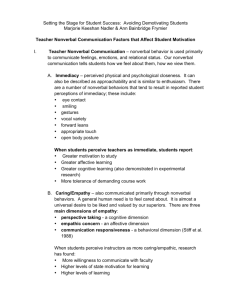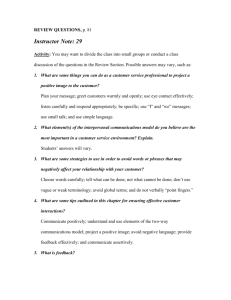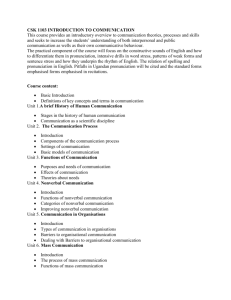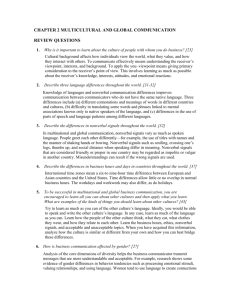NON VERBAL COMMUNICATION TOPICS NONVERBAL
advertisement
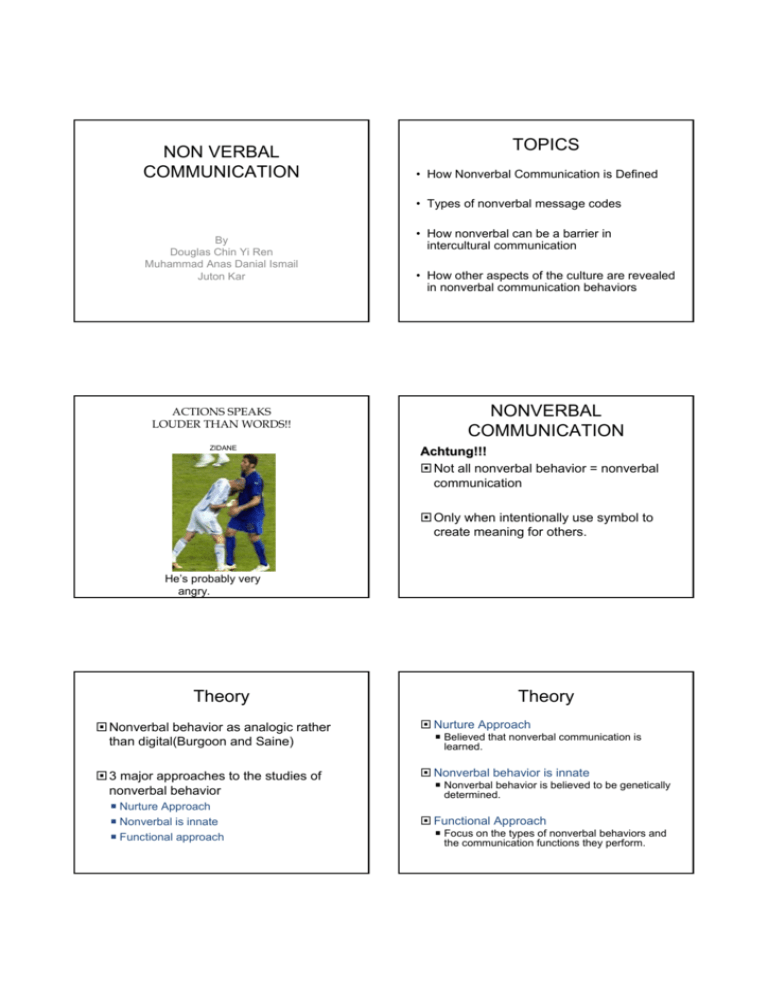
NON VERBAL COMMUNICATION TOPICS • How Nonverbal Communication is Defined • Types of nonverbal message codes By Douglas Chin Yi Ren Muhammad Anas Danial Ismail Juton Kar ACTIONS SPEAKS LOUDER THAN WORDS!! ZIDANE • How nonverbal can be a barrier in intercultural communication • How other aspects of the culture are revealed in nonverbal communication behaviors NONVERBAL COMMUNICATION Achtung!!! Not all nonverbal behavior = nonverbal communication Only when intentionally use symbol to create meaning for others. He’s probably very angry. Theory Theory Nonverbal behavior as analogic rather than digital(Burgoon and Saine) Nurture Approach 3 major approaches to the studies of nonverbal behavior Nonverbal behavior is innate Nurture Approach Nonverbal is innate Functional approach Believed that nonverbal communication is learned. Nonverbal behavior is believed to be genetically determined. Functional Approach Focus on the types of nonverbal behaviors and the communication functions they perform. NONVERBAL COMMUNICATION AS INTENTIONAL COMMUNICATION • Nonverbal communication can be narrowly used to refer to intentional use, as in using a nonspoken symbol to communicate a specific message • Nonverbal communication as those actions and attributes of human that have socially shared meaning, are intentionally sent or interpreted as intentional, are consciously sent or consciously received, and have the potential for feedback from the receiver. Functions • Replacing spoken messages. Forming impressions that guide communication. Making relationships clear. Regulating interaction. Reinforcing and modifying verbal messages. NONVERBAL BEHAVIOR AS CUES • Some basic nonverbal behaviors seem to be reliable cues as to a person’s state of mind. Sending uncomfortable messages. NON VERBAL AS CUES • • Facial expressions are not learned but biologically determined. • Most people can tell what another person’s facial expression means, but there are of course exceptions. Innate behaviors can change as we grow and learn our culture. – Example : • Smile universally recognized as sign of friendliness, it has other meaning to other culture. • Germans smile less than people from US, but doesn’t mean Germans are less friendly. • U.S. wives are usually shown smiling at their husband but Japanese wives are rarely shown smiling. TYPES OF NONVERBAL COMMUNICATION Nonverbal Message The study of nonverbal communication examines how messages are communicated through physical behavior, vocal cues and spatial relationships. • • • • • • • • • Proxemics. Kinesics. Chronemics. Paralanguage. Silence. Haptics. Clothing. Territoriality. Olfactics. PROXEMICS FACTOR • The study of our use of personal distance is proxemics. • “ Cultures differ substantially in their use of personal space“ – Edward Hall(1959). KINESICS PROXEMICS Distance Description Voice Intimate Touching to 18 inches Private situation whisper with people who are emotionally close. Personal 18 inches to 4 feet Handshake distance. Soft voice Casual 4 to 12 feet Distance between Customers and people. Full voice Public 12 feet Teacher in a classroom. Loud voice CHRONEMICS • Chronemics Body language or kinesics : - Body Movement. - Gestures. - Posture. - Facial Expressions. - Eye Contact. “Communication depends heavily on the actions,postures,movements and expression of our bodies“ – by Desmond Morris(1979). – the study of our use of time. – ancient cultures have established their own system in measuring time which differs from one to another. – Example : PARALANGUAGE SILENCE Paralanguage include the following: - Vocal characterizers such as laughter and sobs. - Vocal qualifiers, such as intensity(loud/soft),pitch(high/lo w), extent(clipping). - Vocal segregates, such as “Uh“, “Um“ and “ Uh-huh“. Examples: • • • Loudness indicates strength in Arabic cultures, indicates confidence and authority to the Germans and softness indicates weakness; But it is opposite to Asian culture.Loudness indicates impoliteness to the Thais; indicates loss of control to the Japanese. Generally, one learns not to “shout” in Asia for nearly any reason. Gender based as well: women tend to speak higher and more softly than men. • Muslims use moon-based calendar system, – The usage of time varies from culture to culture. • Example : – Arabs engage in up to half an hour of informal conversation before turning to business. • Silence can communicate – Agreement. – Disagreement. – Confusion. – Respect. – Sadness. – Thoughtfulness, or any number of meanings. USE OF SILENCE IN ASIA HAPTICS – STUDY OF TOUCH • Touch can communicate : “Silence in Asia has commonly been entirely acceptable whereas in the West silence has generally been considered socially disagreeable.“ – Oliver(1971) CLOTHINGS • Clothing can reflect cultural heritage. • Clothing can reflect subgroup identity. • • Example: Example: – Traditional clothing of Gambia – Affection. – Attention. – Announcing a response. – Greetings inclusion. – Departures. – Support. – Sexual interest. By Jones and Yarbrough(1985,United States) TERITORIALITY • Territoriality – refers to how space can be used to communicate messages. – Spaces can encourage democracy (Sennet, 1999). Example : Pnyx and Agora in ancient Greece. – US Army Combat Uniform. Pnyx Agora • Territoriality – each culture have their own customs in space planning. e.g: Feng Shui in Chinese culture OLFACTICS The study of communication via smell is called Olfactics. “In all cultures, women can detect odors in lower concentrations,identify them more accurately and remember them longer than men“ – Doty et al.(1984) Example: • • • Western culture — fear of offensive natural smells (billion dollar industry to mask objectionable odors with what is perceived to be pleasant ) — again connected with “attractiveness” concept. Many other cultures consider natural body odors as normal (Arabic). Asian cultures (Filipino, Malay, Indonesian, Thai, Indian) stress frequent bathing — and often criticize western culture of not bathing often enough! NONVERBAL ISSUES AND MISINTERPRETATION Nonverbal actions and their different meaning due to cultural differences. GESTURES GESTURES Gestures varies from culture to culture For example: • Pointing : US with index finger; Japanese with entire hand,in fact most Asians consider pointing with index finger to be rude. • Counting: Thumb = 1 in Germany, 5 in Japan POSTURE • Bowing (not done, criticized, or affected in US; shows rank in Japan) • Hands in pocket (disrespectful in Turkey) • Sitting with legs crossed (offensive in Ghana, Turkey) • Showing soles of feet. (Offensive in Thailand, Saudi Arabia) • Slouching (rude in most Northern European areas) TOUCH • Touch is culturally determined and each culture has a clear concept of what parts of the body one may not touch. • In Western culture, handshake is common (even for strangers), hugs, kisses for those of opposite gender or of family (usually) on an increasingly more intimate basis. • Most Africans touch on greeting but are annoyed if touched on the head (good boy, good girl overtones). • Islamic and Hindu: typically don’t touch with the left hand. To do so is a social insult. Left hand is for toilet functions. Mannerly in India /Bangladesh(some other Asian countries) to reccive anything from others is only allowed with right hand. • Islamic cultures generally don’t approve of any touching between opposite-sex (even hand shakes). But consider such touching (including hand holding, hugs) between samesex to be appropriate. EYE CONTACT • Western cultures — see direct eye to eye contact as positive (advise children to look a person in the eyes). But within USA, African-Americans use more eye contact when talking and less when listening. • Japan, Africa, Latin American, Caribbean avoid eye contact to show respect. TOUCH THE END • Question : Have you experience any nonverbal misinterpretation that will lead to a serious trouble? Reference • Fred E. Jandt, “Nonverbal Communication,” in An Introduction to Intercultural Communication, Identities in a Global Community, F.E. Jandt. Thousand Oaks, London, New Delhi: Sage Publication, pp.97117. • Andrews University, “Non-Verbal Communication Modes”, http://www2.andrews.edu/~tidwell/bsad560/N onVerbal.html



